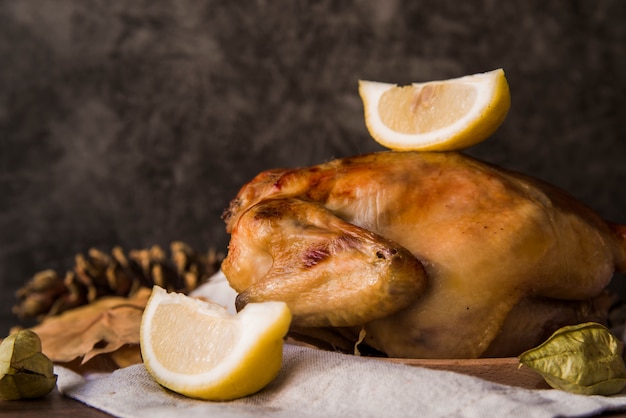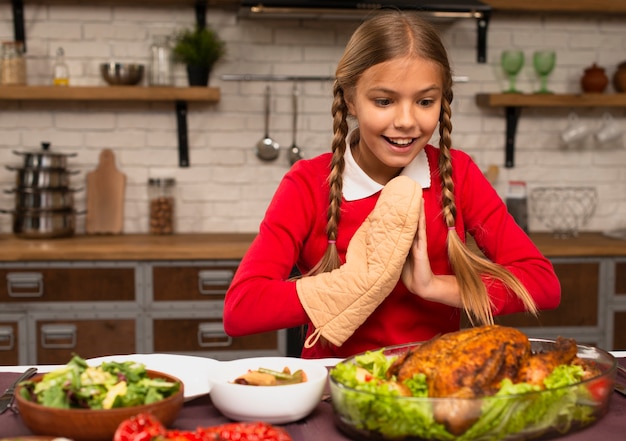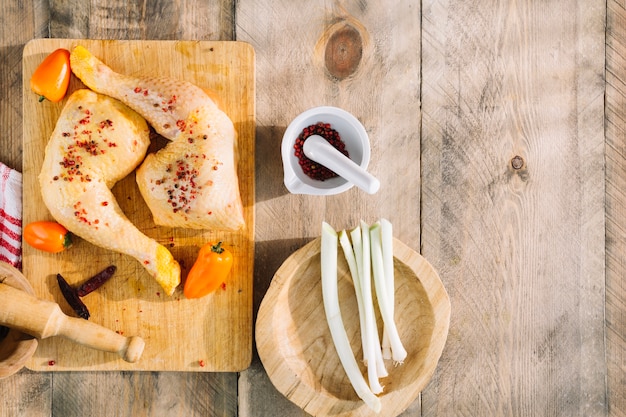(Part 1) Choosing Your Chicken: The Foundation of a Great Meal

First things first, you need to choose the right chicken. This decision sets the stage for your delicious creation, so let's talk about the key factors to consider.
whole chicken vs. chicken pieces: A Matter of Preference
For a beginner, I'd always recommend starting with a whole chicken. It's a great way to learn the ropes, and you'll get a beautiful, evenly cooked bird. A whole chicken is perfect for a family meal, and you'll have plenty of leftovers for sandwiches or a quick meal later in the week. But if you're short on time or just prefer smaller portions, then chicken pieces like breasts, thighs, drumsticks, or wings are excellent choices. It really boils down to what suits your needs and preferences.
Size Matters: Finding the Right Fit
When it comes to size, choose a chicken that's just right for your needs. A small chicken, under 1.5kg, will be perfect for a smaller family or a couple. A larger chicken, maybe 2kg or more, is a good choice for a larger family or if you want to have a lot of leftovers. Personally, I prefer a whole chicken around 1.8kg – it's a good balance for our family and always leaves us with plenty of delicious leftovers.
Organic vs. Conventional: A Matter of Taste and Values
Now, the age-old debate - organic vs. conventional. I'll be honest, I'm a big fan of organic chicken. I love the idea that it's been raised without antibiotics and that the chickens have had access to the outdoors. I also find the taste to be a bit richer. But it can be more expensive, so it's up to you what fits your budget and values. There's no right or wrong answer here, just what feels best for you.
(Part 2) Prepping Your Chicken: Setting the Stage for Flavor

Now that you've got your perfect chicken, it's time to get it prepped. A little bit of upfront effort goes a long way towards a perfectly cooked chicken.
Pat It Dry: The Key to crispy skin
Start by patting the chicken dry with some kitchen paper. This simple step helps the skin to crisp up beautifully when you bake it.
Seasoning is Key: Unleashing Flavor
Now for the fun part – seasoning! I like to keep it simple with salt and pepper, but feel free to get creative with herbs and spices. I always rub a generous amount of seasoning under the skin as well as on the surface. This helps to infuse the chicken with flavor from the inside out. If you're feeling adventurous, try adding some lemon wedges, garlic cloves, or even a few rosemary sprigs inside the cavity. I once tried a recipe with a whole orange cut into wedges and tucked inside the chicken. It was a revelation! The orange juice caramelized during cooking and created the most incredible flavor.
Stuffing (Optional): A Flavorful Addition
If you fancy a stuffed chicken, go for it! There are loads of delicious stuffing recipes out there. But make sure you cook the stuffing separately for at least 15 minutes before adding it to the chicken. This ensures that the stuffing is cooked through and safe to eat. Personally, I'm not a big fan of stuffed chicken. I find it can make the chicken a bit dry, but if you're a stuffing fan, then it's definitely worth trying!
(Part 3) Baking Your Chicken: Turning Up the Heat

Time to bake your masterpiece! Here's what you need to know about getting the baking process just right.
Preheat the Oven: The Foundation for Even Cooking
Always preheat your oven to the right temperature. I usually bake chicken at 180°C (350°F) for a whole chicken. But check your recipe for specific temperature recommendations. A preheated oven ensures that your chicken cooks evenly and gets that lovely golden brown color.
Choose Your Baking Dish: Providing the Right Environment
A roasting pan or a large oven-proof dish is your best bet. Make sure the dish is big enough to hold the chicken comfortably, with a bit of space around it. I like to use a roasting pan with a rack to elevate the chicken and allow air to circulate underneath. This helps to ensure even cooking and prevents the chicken from sitting in its own juices.
Roast It Up: Time to Bake!
Place your seasoned chicken in the baking dish and pop it in the oven. Now, this is where things get a little more specific, depending on the size of your chicken and how you like it cooked.
(Part 4) Calculating Cooking Time: Getting the Timing Right
This is the part that can be a bit tricky, isn't it? The whole chicken cooking time thing. Here's a breakdown of how to estimate the baking time for a whole chicken.
Rule of Thumb: A Starting Point
A good rule of thumb is to bake a whole chicken for about 20 minutes per pound (450g) at 180°C (350°F). So, a 1.8kg chicken would take approximately 72 minutes. However, this is just a starting point. It's always best to use a meat thermometer to check that your chicken is cooked through.
Factors Affecting Cooking Time: Beyond the Basics
Several factors can affect the cooking time, so adjust your estimate accordingly.
- Size: A smaller chicken will cook faster than a larger one.
- Oven: Different ovens can heat at slightly different rates, so you may need to adjust the cooking time.
- Stuffing: If you're stuffing your chicken, it will take longer to cook.
- Chicken Pieces: chicken breasts cook faster than chicken thighs or drumsticks.
(Part 5) Checking for Doneness: Knowing When It's Ready
It's essential to check your chicken is cooked through before serving it. The best way to do this is to use a meat thermometer. Insert the thermometer into the thickest part of the thigh, avoiding bone. The chicken is ready when the internal temperature reaches 74°C (165°F). This is the most reliable way to ensure that your chicken is safe to eat.
Other Signs of Doneness: Additional Clues
While a meat thermometer is the most reliable method, there are other signs to look for. The chicken juices should run clear, not pink, and the skin should be golden brown. However, it's crucial to remember that these are just visual indicators and don't guarantee the chicken is fully cooked.
Resting is Key: Allowing the Juices to Redistribute
Once your chicken is cooked, let it rest for about 10 minutes before carving it. This allows the juices to redistribute, making the meat even more tender and juicy. It's a simple step, but it makes a big difference in the overall taste and texture of the chicken.
(Part 6) Tips for juicy chicken: Maximizing Tenderness
Here are some additional tips to help you achieve that perfectly juicy baked chicken every time.
Basting: Adding Moisture and Flavor
I like to baste my chicken halfway through cooking. This helps to keep it moist and adds flavor. Simply use a spoon to ladle some of the juices from the bottom of the baking pan over the chicken. It's a small step, but it makes a big difference.
Covering the Chicken: Creating a Moist Environment
Covering the chicken with foil for the first part of the cooking time can help to prevent it from drying out. It helps to create a moist environment for the chicken to cook in. However, you'll need to remove the foil for the last 30 minutes or so to allow the skin to crisp up. Experiment with this method to see what works best for you.
Don't Overcook It: The Key to Tenderness
Overcooked chicken is dry and bland. So, check your chicken regularly and don't be afraid to remove it from the oven a little earlier if it seems cooked through. It's always better to have a slightly undercooked chicken than an overcooked one. You can always cook it for a few more minutes if needed.
(Part 7) Serving Your Chicken: A Feast for the Senses
Your chicken is finally cooked, rested, and ready to eat! Get ready for a delicious meal.
Carving Time: A Culinary Art
Use a sharp knife to carve the chicken. Start by removing the legs and thighs. Then, cut the breast into slices.
side dishes: Completing the Culinary Ensemble
Now for the exciting part – the side dishes! Roasted vegetables, creamy mashed potatoes, or a green salad are all perfect accompaniments to baked chicken. I love to roast some potatoes and root vegetables along with the chicken in the same oven. It makes for a lovely one-pan meal.
Sauces and Gravy: Elevating the Flavor
Don't forget the sauces and gravy! You can use the juices from the bottom of the baking pan to make a delicious pan gravy. Alternatively, serve your chicken with a simple lemon butter sauce, or a creamy mushroom sauce.
(Part 8) Storage and Leftovers: Making the Most of Your Meal
After your feast, there's a good chance you'll have some leftovers. Here's how to store them properly.
Refrigerating: Keeping Leftovers Fresh
Allow the chicken to cool completely before storing it in the fridge. It's best to store it in an airtight container. Keep the chicken refrigerated for up to 3 days.
Reheating: Bringing Back the Flavor
To reheat your leftover chicken, you can use the oven, microwave, or a frying pan. Just make sure it's heated through before serving. Leftover chicken is great for salads, sandwiches, or even a chicken pie.
(Part 9) Beyond Basic Chicken: Exploring Flavorful Variations
Now that you've mastered the basics of baking chicken, let's explore some fun variations to spice things up!
Herbs and Spices: A World of Flavor
Experiment with different herbs and spices to create unique flavors. Rosemary, thyme, garlic, lemon, and paprika are all excellent options. I recently tried a recipe with a blend of smoked paprika, cumin, and chili powder. It was a real flavor explosion! You can also use pre-made spice blends designed specifically for chicken.
Marinades: Adding Depth of Flavor
Marinating your chicken before baking can add a burst of flavor and help to keep it moist. A simple marinade of olive oil, lemon juice, garlic, and herbs can do wonders. You can also experiment with other marinades, like honey-soy or teriyaki.
Stuffing Variations: Adding a Flavorful Twist
If you're feeling adventurous, try stuffing your chicken with different ingredients. Some popular options include bread stuffing, wild rice stuffing, or even a sausage stuffing. Just remember to cook the stuffing separately first.
Chicken Breasts: A Versatile Choice
Chicken breasts are a popular choice for baking. They cook quickly and can be easily seasoned. You can also use them in recipes that call for boneless, skinless chicken breasts.
(Part 10) chicken recipes: A culinary journey
Here are a few of my favourite chicken recipes to inspire your next culinary adventure.
roast chicken with Lemon and Herbs: A Classic Delight
This is a classic recipe that's perfect for a weeknight dinner. The lemon and herbs add a fresh, vibrant flavor to the chicken.
Ingredients:
- 1 whole chicken (about 1.8kg)
- 2 lemons, cut into wedges
- 2 tablespoons olive oil
- 1 tablespoon dried thyme
- 1 tablespoon dried rosemary
- 1 teaspoon salt
- 1/2 teaspoon black pepper
Instructions:
- Preheat oven to 180°C (350°F).
- Pat chicken dry with paper towels.
- Rub olive oil all over the chicken.
- Season generously with salt and pepper.
- Stuff the chicken cavity with lemon wedges, thyme, and rosemary.
- Place the chicken in a roasting pan and bake for 1 hour and 15 minutes, or until the internal temperature reaches 74°C (165°F).
- Let the chicken rest for 10 minutes before carving.
Honey Garlic Chicken: Sweet, Savory, and Delicious
This recipe is sweet, savory, and incredibly flavorful. The honey and garlic create a delicious glaze that caramelizes during cooking.
Ingredients:
- 1 whole chicken (about 1.8kg)
- 1/4 cup honey
- 1/4 cup soy sauce
- 2 tablespoons olive oil
- 2 cloves garlic, minced
- 1 teaspoon ginger, minced
- 1/2 teaspoon black pepper
Instructions:
- Preheat oven to 180°C (350°F).
- Pat chicken dry with paper towels.
- In a small bowl, whisk together honey, soy sauce, olive oil, garlic, ginger, and pepper.
- Rub the marinade all over the chicken.
- Place the chicken in a roasting pan and bake for 1 hour and 15 minutes, or until the internal temperature reaches 74°C (165°F).
- Baste the chicken with the remaining marinade halfway through cooking.
- Let the chicken rest for 10 minutes before carving.
Chicken Breasts with Lemon and Herbs: A Simple and Flavorful Option
This is a simple and delicious recipe for chicken breasts. The lemon and herbs add a bright and fresh flavor.
Ingredients:
- 4 boneless, skinless chicken breasts
- 1 lemon, thinly sliced
- 2 tablespoons olive oil
- 1 tablespoon dried thyme
- 1 teaspoon salt
- 1/2 teaspoon black pepper
Instructions:
- Preheat oven to 190°C (375°F).
- Pat chicken breasts dry with paper towels.
- Place chicken breasts in a baking dish. Top each breast with lemon slices.
- Drizzle with olive oil and season generously with salt, pepper, and thyme.
- Bake for 20-25 minutes, or until the internal temperature reaches 74°C (165°F).
- Let the chicken breasts rest for 5 minutes before serving.
(Part 11) FAQs: Addressing Common Questions
Here are some frequently asked questions about baking chicken.
What if my chicken is still pink in the middle?
If your chicken is still pink in the middle, it means it's not cooked through. Don't worry, it's easy to fix. Simply put the chicken back in the oven and bake for another 10-15 minutes, or until the internal temperature reaches 74°C (165°F).
How long should I bake a chicken breast?
A chicken breast will take about 20-25 minutes to bake at 190°C (375°F). But always check the internal temperature with a meat thermometer to ensure it's cooked through.
Can I bake chicken in a slow cooker?
Yes, you can bake chicken in a slow cooker! It's a great way to cook a whole chicken or chicken pieces. Just place the chicken in the slow cooker and cook on low for 6-8 hours, or on high for 3-4 hours.
Can I bake chicken frozen?
It's not recommended to bake chicken frozen. frozen chicken will take much longer to cook and may not cook evenly. It's best to thaw the chicken completely before baking it.
What are some good side dishes for baked chicken?
Roasted vegetables, mashed potatoes, rice, couscous, and salads are all excellent side dishes for baked chicken.
(Part 12) Conclusion: Embark on Your Chicken Baking Journey
So there you have it – the ultimate guide to baking chicken! I hope this has been helpful and given you the confidence to cook a delicious, juicy, and perfectly cooked chicken every time. Remember, the key is to choose the right chicken, prepare it carefully, and check for doneness with a meat thermometer. And don't be afraid to experiment with different herbs, spices, and marinades to create your own signature baked chicken. Happy cooking!
Everyone is watching

How to Cook Frozen Lobster Tails Perfectly: A Step-by-Step Guide
RecipesLobster. Just the word conjures up images of lavish meals, special occasions, and a taste of luxury. But let's...

Pigs in a Blanket Cooking Time: How Long to Bake for Perfect Results
RecipesAh, pigs in a blanket. Just the name conjures up images of those delightful little parcels of crispy pastry en...

Pork Fillet Cooking Time: How Long to Cook It Perfectly
RecipesPork fillet, or tenderloin as it's sometimes called, is a real favourite in our house. It's so versatile, and...

The Ultimate Guide to Cooking Delicious Frankfurters
RecipesLet's face it, we all love a good frankfurter. It's a classic, simple, and always satisfying. But let's be rea...

The Ultimate Guide to Tender, Juicy Pulled Pork
RecipesRight, let's talk pulled pork. It's one of those dishes that just screams "comfort food," doesn't it? I mean...
